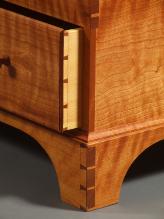 | ||||||
 | ||||||
It is hard explain quality with a few paragraphs and photos. The reality is that you really need to see and experience it first hand to know what the real difference is, and why furniture from my shop is worth it. However, I'll take a stab at describing it, and hope that this can bridge the gap. And I hope you have that first hand knowledge before too long! DESIGN Most of the furniture that comes out of my shop is of my own design. I also do a few that are pretty close to being reproductions, which I freely give credit for. And, I’ve done a few that are quite obviously contemporary, meaning pretty much created from a blank piece of paper and my imagination, always enjoying the process and results. By far the most of what I do, however, is what I call "updated classics," meaning the design is clearly based on something in early American or colonial forms, but now can work in any setting. The lines will be clean and spare, but not severe. Above all, the wood will be making the statement, not the maker. My trestle table is a good example: I certainly didn't invent the form, but you won't find any historical examples that look just like this one. For example, the old ones almost always had thick, almost square or turned, posts; while mine have wider and broader posts. I take elements of many different pieces, make some of my own changes, and recombine them into the whole. While some makers will strive to have consistent "lines" or "collections" of furniture, I really don't. Mine range about quite a bit, in a fun way. However, each individual piece is uniform and cohesive in its form. And everything is most functional, of course. CONSTRUCTION This is one, somewhat technical, aspect of furnituremaking that many persons don't have much knowledge of. But it's easy to show how it makes a big difference. My methods are tried, true, and traditional. Ones that have been used for centuries.
I also design and construct my furniture with allowances for wood movement over the seasons. This is an important consideration, as without it, most any piece of furniture will quickly warp or split very unfortunately. All these factors put together make for a piece that will outlast all of us, and can be handed down for generations. That is my sincere wish. I would be happy to further describe any of these details to you if you are interested. FINISH The first step in finishing is surface preparation. I will use hand planes, scrapers, and fine sandpaper to clean machine marks and smooth the wood. Most of my work is finished naturally with a mixture of oil (linseed and/or tung) and varnish. The oil penetrates the wood and I provide care instructions with each piece that I sell, although frankly, they really don't need much in the way of maintenance. And what there is, it is very easily accomplished by the owner. I do on occasion use other finishes than the natural oil/varnish mix. I can make a good case for painted finishes on some furniture. Windsor chairs are a good example. It emphasizes the form, and takes grain patterns and other potential distractions out of the equation. Also, some of the pieces that are reproductions will do well with a stained finish to simulate age, especially curly maple. The stain will be finished with shellac or varnish. I hate to prematurely age a piece, known as "distressing." I think I'd be more distressed than the wood! So, I am happy to discuss finishes for your project. If you have read through all this essay, you will have a better idea of my methods and philosophy. But it’s just the tip of the iceberg, of course, so please do contact me to continue the discussion. GUARANTEE It’s 100% customer satisfaction. See details on the "How to Buy" page. | ||


